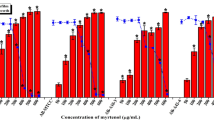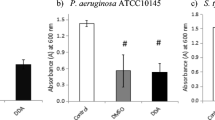Abstract
The present study was aimed to investigate the antibiofilm activity of 5-hydroxymethylfurfural against Acinetobacter baumanni and Vellar estuary isolates v3 (Acinetobacter nosocomialis). The biofilm inhibitory concentration (BIC) of 5HMF against A. baumannii and v3 (A. nosocomialis) was found to be 100 µg/ml) exhibited non-bactericidal concentration-dependent antibiofilm activities against Acinetobacter species. The present study found that 5HMF treatment is very effective in the initial stage of A. baumannii biofilms and it significantly disrupted the mature biofilms. Moreover, 5HMF treatment inhibited the extracellular polymeric substances (EPS), including polysaccharides and proteins production. Results from gene expression and in vitro assays further demonstrated the 5HMF treatment downregulated the expression of bfmR, bap, csuA/B, ompA and katE virulence genes, which consistently affects biofilm formation and its mediated virulence property. The present study suggests that 5HMF unveil its antibiofilm activity by interfering initial biofilm formation and suppressing the virulence regulator genes in A. baumannii. Further studies are required to explore the 5HMF mode of action responsible for the antibiofilm activity.






Similar content being viewed by others
References
Bhargava N, Sharma P, Capalash N (2014) Pyocyanin stimulates quorum sensing-mediated tolerance to oxidative stress and increases persister cell populations in Acinetobacter baumannii. Infect Immun 82:3417–3425
Brossard KA, Campagnari AA (2012) The Acinetobacter baumannii biofilm-associated protein plays a role in adherence to human epithelial cells. Infect Immun 80:228–233
Chang Y, Gu W, McLandsborough L (2012) Low concentration of ethylenediaminetetraacetic acid (EDTA) affects biofilm formation of Listeria monocytogenes by inhibiting its initial adherence. Food Microbiol 29:10–17
Choi CH, Lee EY, Lee YC, Park TI, Kim HJ, Hyun SH, Kim SA, Lee SK, Lee JC (2005) Outer membrane protein 38 of Acinetobacter baumannii localizes to the mitochondria and induces apoptosis of epithelial cells. Cell Microbiol 7:1127–1138
Cowan MM (1999) Plant products as antimicrobial agents. Clin Microbiol Rev 12:564–582
Doyle RJ (2000) Contribution of the hydrophobic effect to microbial infection. Microb Infect 2(4):391–400
Dubois M, Gilles KA, Hamilton JK, Rebers PA, Smith F (1951) A colorimetric method for the determination of sugars. Nature 168:167
Gaddy JA, Actis LA (2009) Regulation of Acinetobacter baumannii biofilm formation. Future Microbiol 4:273–278
Garnacho J, Sole-Violan J, Sa-Borges M, Diaz E, Rello J (2003) Clinical impact of pneumonia caused by Acinetobacter baumannii in intubated patients: a matched cohort study. Crit Care Med 31:2478–2482
Jiao Y, Cody GD, Harding AK, Wilmes P, Schrenk M, Wheeler KE, Banfield JF, Thelen MP (2010) Characterization of extracellular polymeric substances from acidophilic microbial biofilms. Appl Environ Microbiol 76:2916–2922
Kannappan A, Sivaranjani M, Srinivasan R, Rathna J, Pandian SK, Ravi AV (2017) Inhibitory efficacy of geraniol on biofilm formation and development of adaptive resistance in Staphylococcus epidermidis RP62A. J Med Microbiol 66:1506–1515
Karuppiah V, Thiruganasambandam R (2017) Antibiofilm and quorum sensing inhibitory potential of Excoecaria agallocha against Pseudomonas aeruginosa. Int J Sci Invent Today 6:758–771
Karuppiah V, Thiruganasambandam R (2018) Anti-biofilm and quorum sensing inhibitory potential of Acanthus ilicifolius against uropathogens. LS Int J Life Sci 7:65–74
Karuppiah V, Thirunanasambandham R (2020) Quebrachitol from Rhizophora mucronata inhibits biofilm formation and virulence production in Staphylococcus epidermidis by impairment of initial attachment and intercellular adhesion. Arch Microbiol 7:1–4
Kim SW, Choi CH, Moon DC, Jin JS, Lee JH, Shin JH, Kim JM, Lee YC, Seol SY, Cho DT, Lee JC (2009) Serum resistance of Acinetobacter baumannii through the binding of factor H to outer membrane proteins. FEMS Microbiol Lett 301:224–231
Kwon HI, Kim S, Oh MH, Na SH, Kim YJ, Jeon YH, Lee J (2017) Outer membrane protein A contributes to antimicrobial resistance of Acinetobacter baumannii through the OmpA-like domain. J Antimicrob Chemother 72:3012–3015
Limoli DH, Jones CJ, Wozniak DJ (2015) Bacterial extracellular polysaccharides in biofilm formation and function. Microbiol Spectr 7:223–247
Loehfelm TW, Luke NR, Campagnari AA (2008) Identification and characterization of an Acinetobacter baumannii biofilm-associated protein. J Bacteriol 190:1036–1044
Mah TF, O'Toole GA (2001) Mechanisms of biofilm resistance to antimicrobial agents. Trends Microbiol 9:34–39
Nemec A, Krizova L, Maixnerova M, van der Reijden TJ, Deschaght P, Passet V, Vaneechoutte M, Brisse S, Dijkshoorn L (2011) Genotypic and phenotypic characterization of the Acinetobacter calcoaceticus–Acinetobacter baumannii complex with the proposal of Acinetobacter pittii sp. nov. (formerly Acinetobacter genomic species 3) and Acinetobacter nosocomialis sp. nov. (formerly Acinetobacter genomic species 13TU). Res Microbiol 162:393–404
Oh ET, So JS (2003) A rapid method for RNA preparation from Gram-positive bacteria. J Microbiol Methods 52:395–398
Peleg AY, Seifert H, Paterson DL (2008) Acinetobacter baumannii: emergence of a successful pathogen. Clin Microbiol Rev 21:538–582
Rodríguez-Baño J, Marti S, Soto S, Fernández-Cuenca F, Cisneros JM, Pachón J, Pascual A, Martínez-Martínez L, McQueary C, Actis LA, Vila J (2008) Biofilm formation in Acinetobacter baumannii: associated features and clinical implications. Clin Microbiol Infect 14:276–278
Romero D, Aguilar C, Losick R, Kolter R (2010) Amyloid fibers provide structural integrity to Bacillus subtilis biofilms. Proc Nat Acad Sci 107:2230–2234
Rubin H, Selwood T, Yano T, Weaver DG, Loughran HM, Costanzo MJ, Scott RW, Wrobel JE, Freeman KB, Reitz AB (2015) Acinetobacter baumannii OxPhos inhibitors as selective anti-infective agents. Bioorg Med Chem Lett 25:378–383
Russo TA, Manohar A, Beanan JM, Olson R, MacDonald U, Graham J, Umland TC (2016) The response regulator BfmR is a potential drug target for Acinetobacter baumannii. mSphere 1:e00082–e116
Sato Y, Unno Y, Kawakami S, Ubagai T, Ono Y (2017) Virulence characteristics of Acinetobacter baumannii clinical isolates vary with the expression levels of omps. J Med Microbiol 66:203–212
Sivaranjani M, Srinivasan R, Aravindraja C, Karutha Pandian S, Veera Ravi A (2018) Inhibitory effect of α-mangostin on Acinetobacter baumannii biofilms–an in vitro study. Biofouling 34:579–593
Subramenium GA, Vijayakumar K, Pandian SK (2015) Limonene inhibits streptococcal biofilm formation by targeting surface-associated virulence factors. J Med Microbiol 64:879–890
Tatsuno I, Isaka M, Okada R, Zhang Y, Hasegawa T (2014) Relevance of the two-component sensor protein CiaH to acid and oxidative stress responses in Streptococcus pyogenes. BMC Res Notes 7:189
Thompson RJ, Bobay BG, Stowe SD, Olson AL, Peng L, Su Z, Actis LA, Melander C, Cavanagh J (2012) Identification of BfmR, a response regulator involved in biofilm development, as a target for a 2-aminoimidazole-based antibiofilm agent. Biochemistry 51:9776–9778
Tomaras AP, Dorsey CW, Edelmann RE, Actis LA (2003) Attachment to and biofilm formation on abiotic surfaces by Acinetobacter baumannii: involvement of a novel chaperone-usher pili assembly system. Microbiology 149:3473–3484
Tseng SP, Hung WC, Huang CY, Lin YS, Chan MY, Lu PL, Lin L, Sheu JH (2016) 5-Episinuleptolide decreases the expression of the extracellular matrix in early biofilm formation of multi-drug resistant Acinetobacter baumannii. Mar Drugs 14:143
Untergasser A, Cutcutache I, Koressaar T, Ye J, Faircloth BC, Remm M, Rozen SG (2012) Primer3- new capabilities and interfaces. Nucleic Acids Res 40:e115
van Loosdrecht MC, Norde W, Lyklema J, Zehnder AJ (1990) Hydrophobic and electrostatic parameters in bacterial adhesion. Aquat Sci 52:103–114
Vatansever F, de Melo WC, Avci P, Vecchio D, Sadasivam M, Gupta A, Chandran R, Karimi M, Parizotto NA, Yin R, Tegos GP (2013) Antimicrobial strategies centered around reactive oxygen species–bactericidal antibiotics, photodynamic therapy, and beyond. FEMS Microbiol Rev 37:955–989
Vijayakumar K, Ramanathan T (2018) Antiquorum sensing and biofilm potential of 5-Hydroxymethylfurfural against Gram positive pathogens. Microb Pathog 125:48–50
Vijayakumar K, Ramanathan T (2020) Musa acuminata and its bioactive metabolite 5-Hydroxymethylfurfural mitigates quorum sensing (las and rhl) mediated biofilm and virulence production of nosocomial pathogen Pseudomonas aeruginosa in vitro. J Ethnopharmacol 246:112242
Viszwapriya D, Subramenium GA, Prithika U, Balamurugan K, Pandian SK (2016) Betulin inhibits virulence and biofilm of Streptococcus pyogenes by suppressing ropB core regulon, sagA and dltA. FEMS Pathog Dis 74:ftw088
Wang X, Zhang L, Sun A, Yang X, Sang W, Jiang Y, Cheng J, Wang J, Zhou M, Chen B, Ouyang J (2017) Acinetobacter baumannii bacteraemia in patients with haematological malignancy: a multicentre retrospective study from the Infection Working Party of Jiangsu Society of Hematology. Eur J Clin Microbiol Infect Dis 36:1073–1081
Wareham DW, Bean DC, Khanna P, Hennessy EM, Krahe D, Ely A, Millar M (2008) Bloodstream infection due to Acinetobacter spp: epidemiology, risk factors and impact of multi-drug resistance. Eur J Clin Microbiol Infect Dis 27:607
Zarrilli R, Giannouli M, Tomasone F, Triassi M, Tsakris A (2009) Carbapenem resistance in Acinetobacter baumannii: the molecular epidemic features of an emerging problem in health care facilities. J Infect Dev Ctries 3:335–341
Zhao L, Chen J, Su J, Li L, Hu S, Li B, Zhang X, Xu Z, Chen T (2013) In vitro antioxidant and antiproliferative activities of 5-hydroxymethylfurfural. J Agri Food Chem 61:10604–10611
Acknowledgements
The authors gratefully thank Dr. G. Ashwinkumar Subramenium and Dr. S. Muhil vannan Seralathan, PAR Life Sciences and Research Pvt Ltd for support in discussing and fulfilling the work. This research did not receive any specific grant from funding agencies in the public, commercial, or not-for-profit sectors.
Author information
Authors and Affiliations
Corresponding author
Ethics declarations
Conflict of interest
The authors declare that they have no conflict of interest.
Research involving human participants and animals
This study does not contain any experiments with human participants or animals performed by any of the authors.
Additional information
Communicated by Erko stackebrandt.
Publisher's Note
Springer Nature remains neutral with regard to jurisdictional claims in published maps and institutional affiliations.
Rights and permissions
About this article
Cite this article
Vijayakumar, K., Thirunanasambandham, R. 5-Hydroxymethylfurfural inhibits Acinetobacter baumannii biofilms: an in vitro study. Arch Microbiol 203, 673–682 (2021). https://doi.org/10.1007/s00203-020-02061-0
Received:
Revised:
Accepted:
Published:
Issue Date:
DOI: https://doi.org/10.1007/s00203-020-02061-0




